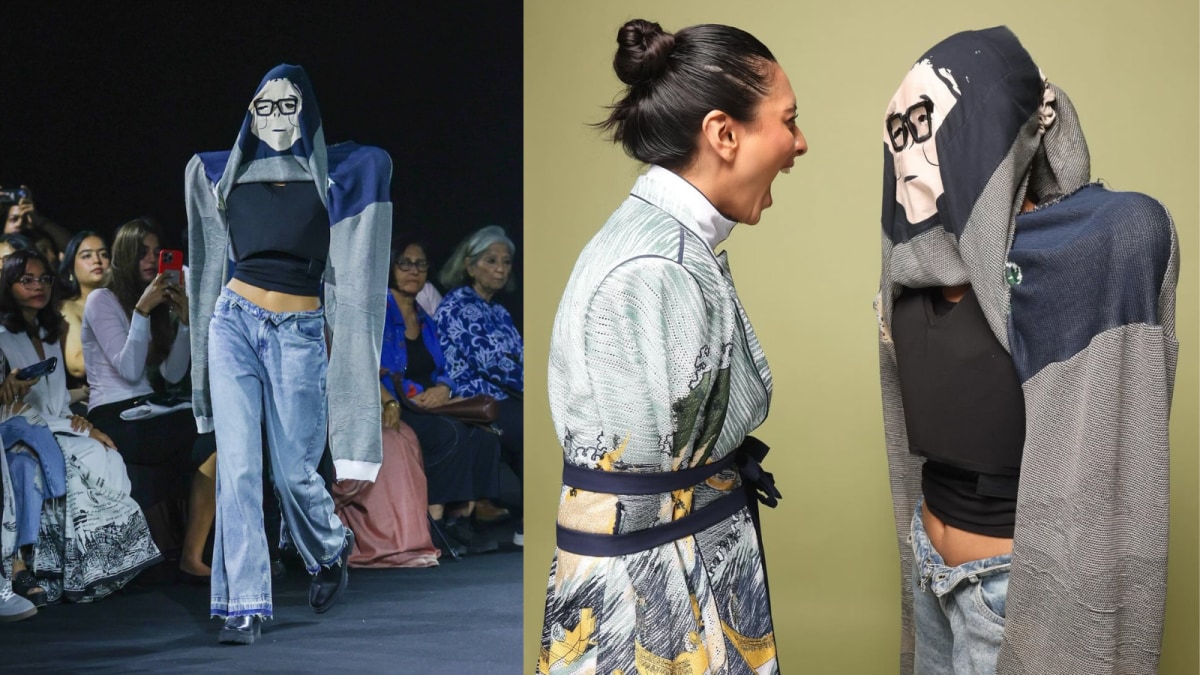Last Updated:
Decoding 5 avant-garde runway looks from Anurag Gupta’s collection – An ode to Hokusai.

Fashion designer Anurag Gupta is here to dismantle, disrupt and redefine fashion.
Unconventional, Experimental and Engineered is how Anurag Gupta describes his collection – An Ode To Hokusai, he showcased at Lakmē Fashion Week x FDCI Delhi edition.
Anurag has always had a fascination with doing things in unconventional ways, even when it comes to embroidery. For this collection, Anurag collaborated with IIT Delhi for their patented woolen denim – Indiwool Denim, making this showcase a sustainable narrative where avant-garde art met conscious fashion.
Why does fashion have to be disruptive for Anurag Gupta?
For me, fashion is emotion. It’s different for everyone, for some, it’s beautifully done embroideries, delicate florals, and perfect craftsmanship. That’s how they express their emotions. But for me, fashion has always been a reflection of my inner world — chaotic, unpredictable, sometimes even absurd. My life has been disruptive since the beginning — from my early childhood to the way I built my brand. I never planned for my collections to look disruptive, but they always end up that way. Every collection is an emotion I can’t say in words. It’s my way of showing my absurdism, my defiance, and my truth.
Each ensemble in the collection told a story through design and art, were you satisfied with what you showcased at Lakme Fashion Week x FDCI?
Every year, I’m deeply satisfied with what I showcase but that satisfaction doesn’t come easily. I never send a garment to the ramp that merely feels ‘okay’ or ‘good enough’. Every look, every stitch, every detail has to reach a point where it completely satisfies me. I hold onto that piece for weeks, even months, until I find that missing element. Only when that moment of completion arrives — when the garment feels whole — do I allow it to walk the ramp. Because for me, every ensemble is not just a design; it’s a statement, and it deserves to be shown only in its most complete form.
Indiwool Denim played a major role in executing this collection, what made you choose it and did it do justice to your vision?
Every time I create a collection, I try to bring in a new technological advancement — something that pushes textile innovation forward while still remaining commercially viable. In my GenNext (2018) collection, I developed textiles that charged under light and glowed in the dark, and explored embroidery inspired by metamorphosis. Last year, I worked on a knitted material that changes shape when heated — it could be knitted in any colour or pattern and would transform with temperature.
This year, I wanted to find another innovation that felt equally progressive yet wearable. After brainstorming, I reached out to IIT Delhi and IIT Mumbai to explore their textile developments. Through a friend, I was introduced to the IIT Incubation Centre, where I discovered Indigotex and their patented woolen denim.
I saw immense potential in this fabric — its structure, warmth, and flexibility — and decided to integrate it with my engineered embroidery techniques. The result was a collection that not only aligned with my vision but also truly justified my constant pursuit of technological advancement in fashion. So yes, I believe this fabric did justice to my vision — it’s the most advanced textile experiment I’ve brought to the ramp so far.
Decoding 5 Avant-Garde Runway Looks From Anurag Gupta’s Collection – An Ode To Hokusai
Look 1: The Suspended Balloons
At first glance, the garment looks simple. But beneath that simplicity lies an incredibly complex construction. The biggest challenge for Anurag Gupta was to make the balloons appear as if they were truly holding and stretching the garment. The balloons are crafted from papier-mâché, keeping them light yet textured, and inside the garment, there’s a steel jacket framework with rods that hold the balloons in place, maintaining their suspension and tension. Every inch of that illusion — every hidden wire, rod, stitch, and joint — is carefully concealed within the garment. The simpler it looks, the more engineering it hides.
The spectacles the model is wearing came from another moment of pure improvisation. “I had an old broken scissor lying around at home, so I brought it to the studio without knowing what I’d do with it. We started experimenting, spray-painted it, added threads and glass pieces and slowly, something unexpected took shape. It became this eccentric accessory that complemented the garment perfectly,” adds Anurag.
For the bottoms, Anurag constructed navy blue denim pants made from the IIT Delhi–patented woolen denim fabric. The pairing added balance — the grounded strength of the denim contrasting with the surreal lightness of the upper piece.
Look 2: Flex It!
Anurag Gupta opened his show with a dramatic look on the runway. The thought behind this garment came from a flex provided by the Lakmē team in 2024 for the FDCI stockroom. “Every year, they share a new flex featuring the brand’s imagery or campaign visuals for the stall, and this particular one has been on our office wall since then. I see it every day. I like to find potential in everything around me. So, I thought, why can’t this flex be brought to life on the ramp,” expresses Anurag. The upcycled flex was further enhanced with engineered embroidery on cotton canvas.
“The main challenge was to ensure it still looked like a flex on the runway, yet leave the audience stunned when that very flex began to move. This unexpected transformation — from a static display to a living, moving expression — became the core idea,” adds Anurag.
Look 3: The Papier-Mâché Heart
The idea for this garment came to Anurag while he was watching Jim Carey’s iconic film, The Mask. “There’s a scene where the protagonist’s heart bursts out of his body and beats right in front of him — wild, exaggerated, and full of life. That moment stayed with me. It made me wonder: what if a garment could capture that same drama — where the heart feels like it’s coming out of the body, alive and visible,” says Anurag. Initially, Anurag created the corset with just the papier-mâché heart but it didn’t feel enough. So, he started adding more texture in the form of old keys, pins, bits of metal.
For the bottom, he paired the corset with denim developed in collaboration with IIT Delhi, and on that, he did his Hokusai-inspired engineered embroidery. “I love how this combination bridges two worlds — the scientific and the artistic, the structured and the chaotic,” adds Anurag.
Look 4: Wear Your Shoes On Your Sleeve
According to Anurag, originally, the shoes were developed specifically for the show. However, one day he spotted one of his employees holding them and walking around. “An idea immediately struck me — these shoes had enormous creative potential. I began experimenting, placing them on different parts of the body: on hands, elbows, and shoulders, until they finally found their place on the shoulders. From there, I envisioned a seamless garment — a jacket made out of rexine that would literally integrate the shoes into its construction. As you saw on the runway, the shoes and garment become one, creating a truly seamless experience,” shares Anurag.
Look 5: Finding Art In Discarded Objects
The coat dress layered over a dress carries a sense of structure and movement. For the mask, Anurag’s team went sourcing and came back with a seat cover almost like a chair cover. “It was such a strange object, and that’s exactly what made it interesting to me. I’ve always been drawn to using weird, unexpected things in my collections, so I decided to embroider on the mask as well, merging the absurd with the beautiful,” adds Anurag.
This garment features another artwork by Hokusai, completely embroidered. Anurag also had this denim belt that he had made a long time ago. Crafted from discarded denim, Anurag decided to add it onto the mask and it brought in that extra bit of drama and deconstruction to the ensemble.

Completing almost two decades in journalism, Akshata Shetty’s journey from print to online journalism is a celebration of fashion, art and music. Akshata’s fashion stories are about the people who celebrate the…Read More
Completing almost two decades in journalism, Akshata Shetty’s journey from print to online journalism is a celebration of fashion, art and music. Akshata’s fashion stories are about the people who celebrate the… Read More
October 30, 2025, 11:50 IST















